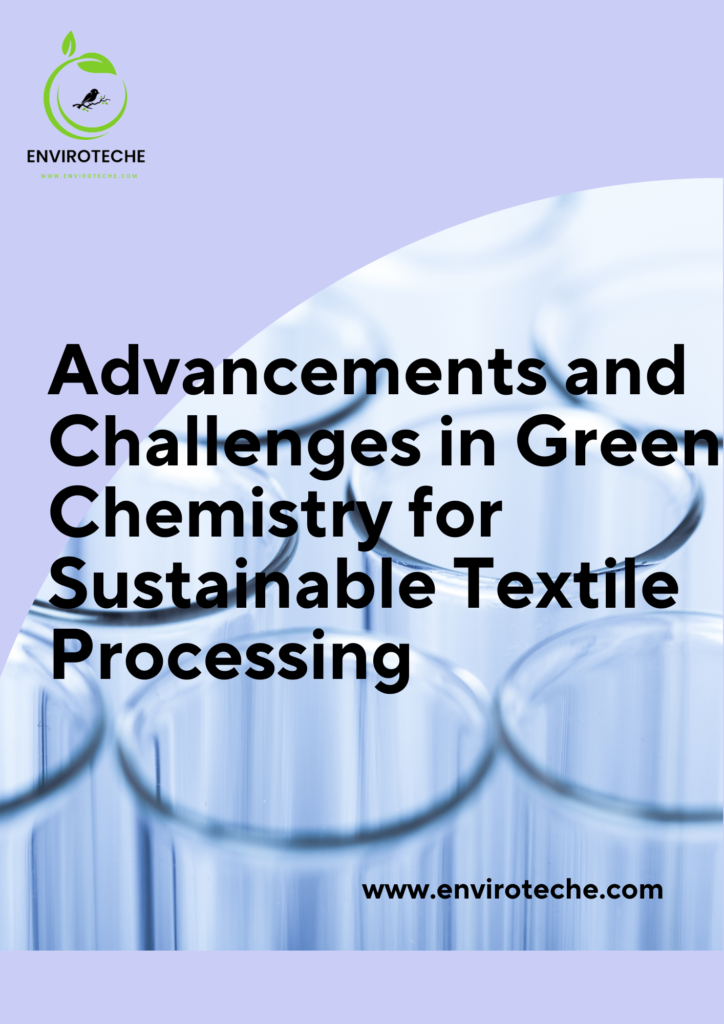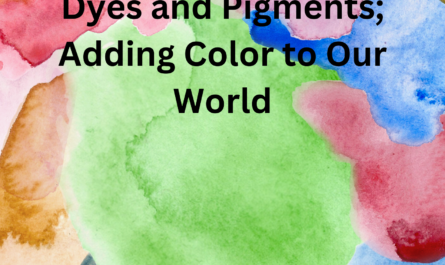Table of Contents

Green Chemistry
The field of “Green Chemistry” plays a pivotal role in various stages of textile manufacturing and handling. Encompassing the entire life cycle of chemical products, including creation, application, and final disposal, green chemistry strives to minimize or eliminate the production of hazardous substances through innovative design of chemical goods and processes. Textile coloring and finishing, critical aspects of the textile industry, are subjected to the principles of green chemistry to ensure sustainability and environmental responsibility.
The close interconnection between the textiles and chemical manufacturing sectors necessitates advancements in the latter to enhance the former. As the textile industry grapples with the challenges posed by the increased use of synthetic compounds and the associated risks, there is a growing shift towards sustainable approaches. The surge in population and consumer demand for fashionable textiles exerts substantial pressure on the fiber chemical industry to escalate production.
However, a closer examination reveals that the prevalent use of synthetic materials involves a considerable amount of chemicals, posing challenges in terms of breakdown and intricate interactions (Raj et al., 2022).
Principles of Green Chemistry
- Waste management is the process of reducing or eliminating waste.
- Atom economy by minimal or nonexistent atom waste.
- Direct reactions employ as few or no reaction steps as possible; the derivatives or intermediate processes require more reagents and may produce more waste.
- Synthetic processes ought to be created using materials that are either minimally or completely non-toxic to the environment and human health.
- The renewable raw materials employ non-depleting and renewable feedstocks.
What are the Advancements in Green Chemistry for Sustainable Textile Processing?
- Waterless Dyeing Technologies
The process of dyeing without the use of water is called waterless dyeing. It is a procedure that produces amazing shades in solids and designs without using any water or energy, unlike traditional dying techniques. There is less need for time, chemicals, auxiliaries, and processes in the waterless dyeing method. In addition to being one of the biggest users of water, the textile sector also contributes to environmental pollution through chemically treated waste. One kilogram of fabrics is thought to require 100–150 liters of water on average to process. Many businesses are attempting to reduce their water usage through recycling, dye sublimation, conservation, and other innovative technologies (Shahid & Mohammad, 2013).
The main ingredient, water, is utilized as the solvent in pre-treatment processes and finishing procedures such as scouring, bleaching, dyeing, and rinsing. The textile dyeing and treatment industry is responsible for 17–20% of industrial water pollution, according to the World Bank. Water was the only option available for cloth dyeing up to a few years ago (Ahmed et al., 2022).
- Sustainable Fiber Production
The common method for the use of sustainable textiles is offered by sustainable fibers, covering everything from fiber production to manufacturing, low-energy maintenance, and recycling. In addition, it examines sustainable fiber quality about important environmental and social standards (Nagajyothi et al., 2020).
- Energy Efficient Manufacturing Processes
Chemical process energy requirements should be reduced in light of their potential negative effects on the environment and the economy. Synthetic methods ought to be carried out at room temperature and pressure, if at all possible. Examples include specific enzymes and antibodies. Green chemicals, materials, and chemical reactions are environmentally friendly, highly energy-efficient, sustainable, and produce less waste than conventional petroleum-based materials and chemical processes.
Environmentally friendly textile materials and wet processing stages have been achieved recently through a variety of initiatives. To achieve a circular economy and waste-free concepts, these include increasing the use of natural color green fibers, green color fiber manufacturing processes, organic and green dyes and assistants, solvents, customized and energy-efficient handling with water and chemical recycling, bioprocessing, the removal of hazardous substances, and the reuse of textile materials (Mohammad, 2014).
- Eco-Friendly Softeners And Finishing Agents
These include the dyeing, finishing, covering, and functioning of textile materials using natural and biodegradable materials as well as the use of sustainable technologies like plasma, microwave, UV, and supercritical CO2. Eco-friendly finishes are appropriate textile processing techniques that produce finished goods that are not only environmentally friendly but also do not negatively impact the surrounding air quality and environment through the release of harmful gases into the atmosphere and wastewater discharges
- Consumer Awareness and Demand
The main goal of ecological advertising is to raise public awareness of environmental problems and the ways that switching to green products can benefit the environment. Therefore, the goal of green marketing is to enlighten people and provide them with more options for adopting a green lifestyle.
Challenges In Green Chemistry For Sustainable Textile Processing
Green chemistry may have advantages, but its adoption and advancement are hampered by several obstacles and problems. These include a deficiency in knowledge and instruction, rules and rewards, infrastructure and standards, teamwork and communication, and infrastructure and standards (Kumar et al., 2019).
- Waste-Management
Challenges in the textile industry for applying green chemistry are evident in waste management practices. Inefficient waste management systems contribute to environmental issues such as air pollution, water pollution, and soil contamination. The inadequacy of data collection systems and improper disposal methods exacerbate these problems. Open and unregulated landfills, often containing hazardous materials from the textile industry, not only pose a risk of transmitting diseases but also lead to infections and the contamination of drinking water sources. Addressing waste management challenges is crucial to fostering sustainable practices and reducing the environmental impact of textile manufacturing.
How to Reduce Waste Management?
Instead of stoichiometric reagents, use catalysts: Reduce waste through the use of catalytic processes. Small amounts of catalysts work well and can repeatedly complete a single reaction. They are better than reagents used which are overused and only perform a single reaction (Nambela et al., 2020).
- Technological Innovation Barriers
These are explained below in Table 1.
| Economical and Financial Barriers | Regulatory Barriers | Technical Barriers |
| Cost | Uncertainty | Expertise |
| Incentives | Timing | Training |
| Markets | Disincentives | Scientific and Engineering Issues |
Table 1. Challenges In Green Chemistry For Sustainable Textile Processing
- Transition Period Challenges
Redefining financial structures and policies is necessary to make sure sustainable development for the environment while promoting economic development and social well-being in the shift to a green economy. It entails implementing policies that support resource conservation, reduce carbon emissions, and support renewable energy sources (Islam & Butola, 2018).
It mainly discusses four challenges described below:
- It deals with more harsh and global environmental threats
- It deals with achieving more sustainable technological variations
- It deals with green capitalism and business scenario
- The work of the state and establishing suitable policy
Conclusion
It is only possible to attain environmentally friendly production and consumption when all parties involved in the market accept accountability. Environmental considerations should be included in all decision-making processes by retailers, customers, and industrialists. The production of many products under improved circumstances with more concern for the environment, such as by using fewer resources, achieving better yields, causing less pollution of the air or water, generating less waste, and producing fewer (or no) unintentional by-products, has led to a change in the attitudes of manufacturers. Since the textile industry still uses wet processing, it is obvious that there is still room for it to “green” its operations and the chemistry associated.
References
Ahmed, S. F., Mofijur, M., Rafa, N., Chowdhury, A. T., Chowdhury, S., Nahrin, M., Islam, A. S., & Ong, H. C. (2022). Green approaches in synthesizing nanomaterials for environmental nanobioremediation: Technological advancements, applications, benefits and challenges. Environmental Research, 204, 111967.
Islam, S. U., & Butola, B. S. (2018). The impact and prospects of green chemistry for textile technology. Woodhead Publishing.
Kumar, D., Pandit, P. D., Patel, Z., Bhairappanavar, S. B., & Das, J. (2019). Perspectives, scope, advancements, and challenges of microbial technologies treating textile industry effluents. In Microbial Wastewater Treatment (pp. 237-260). Elsevier.
Mohammad, F. (2014). Emerging green technologies and environment friendly products for sustainable textiles. Roadmap to Sustainable Textiles and Clothing: Environmental and Social Aspects of Textiles and Clothing Supply Chain, 63-82.
Nagajyothi, P. C., Prabhakar Vattikuti, S. V., Devarayapalli, K. C., Yoo, K., Shim, J., & Sreekanth, T. V. M. (2020). Green synthesis: Photocatalytic degradation of textile dyes using metal and metal oxide nanoparticles-latest trends and advancements. Critical Reviews in Environmental Science and Technology, 50(24), 2617-2723.
Nambela, L., Haule, L. V., & Mgani, Q. (2020). A review on source, chemistry, green synthesis and application of textile colorants. Journal of Cleaner Production, 246, 119036.
Raj, A., Chowdhury, A., & Ali, S. W. (2022). Green chemistry: Its opportunities and challenges in colouration and chemical finishing of textiles. Sustainable Chemistry and Pharmacy, 27, 100689.
Shahid, M., & Mohammad, F. (2013). Green Chemistry Approaches to Develop Antimicrobial Textiles Based on Sustainable Biopolymers A Review. Industrial & Engineering Chemistry Research, 52(15), 5245-5260.
Author detail:
Aisha Ghaffar, Razia Yaseen
Department of Chemistry, University Of Agriculture Faisalabad, Sub-Campus Toba Tek Singh
Check Other Scholarships:


